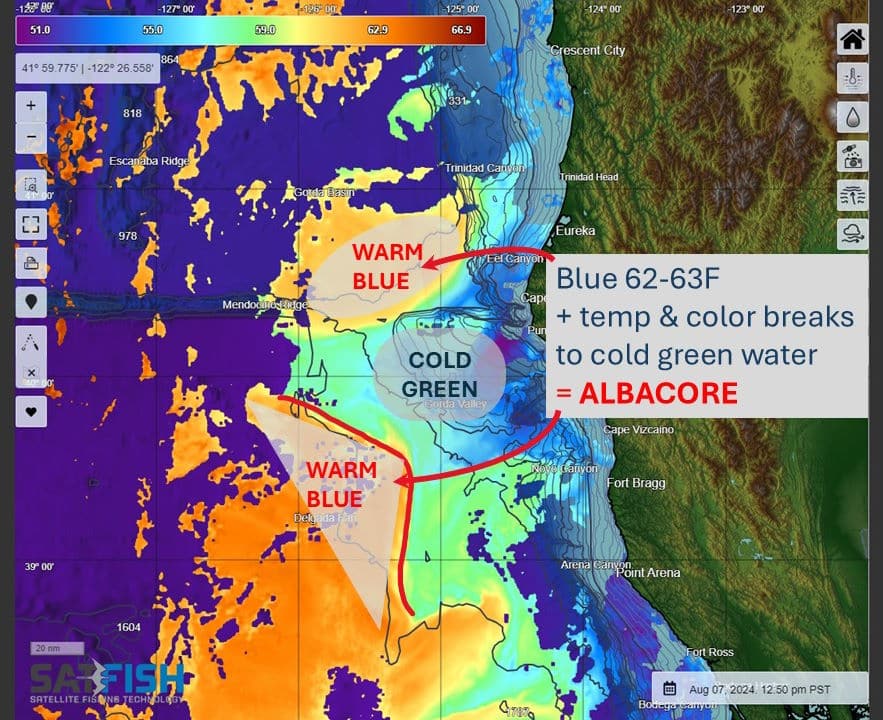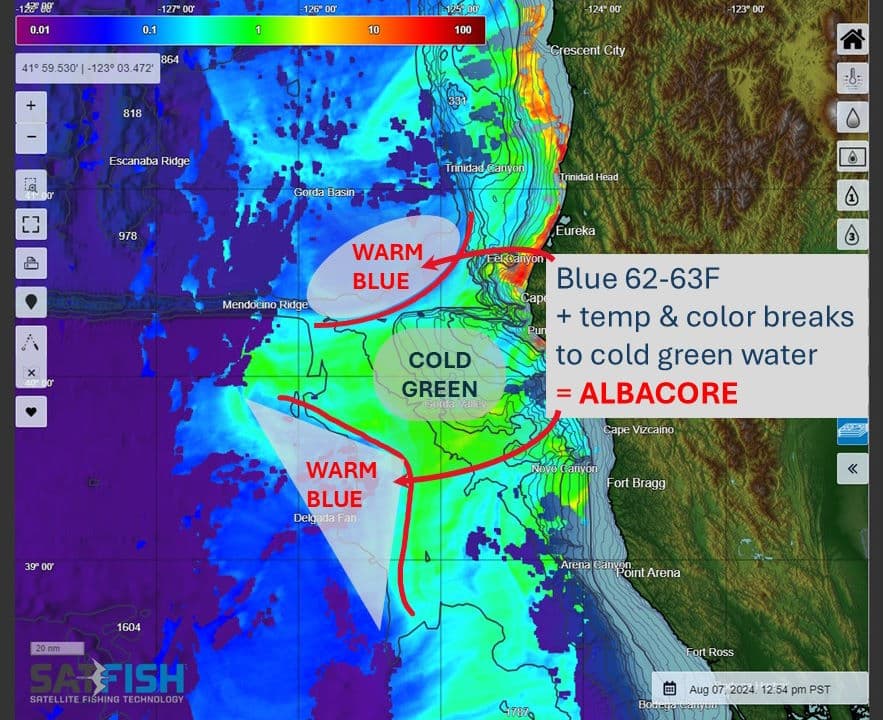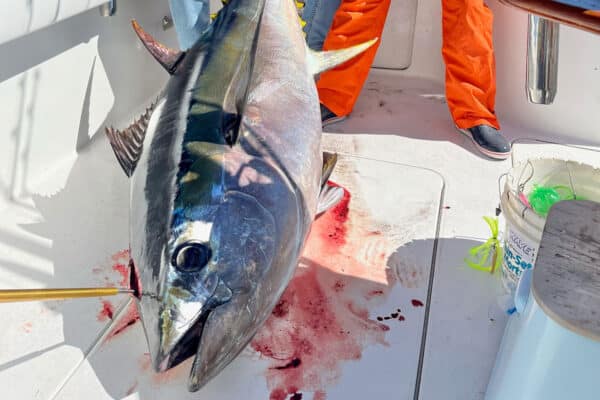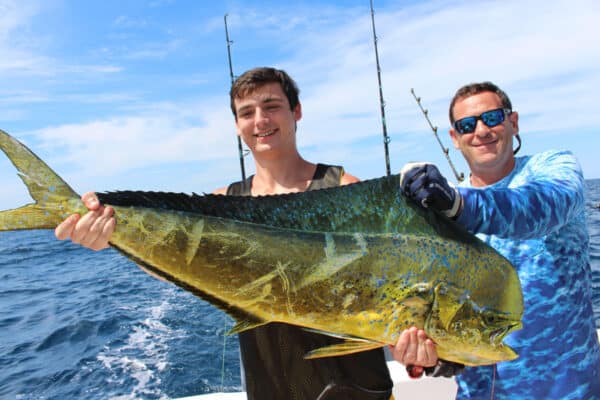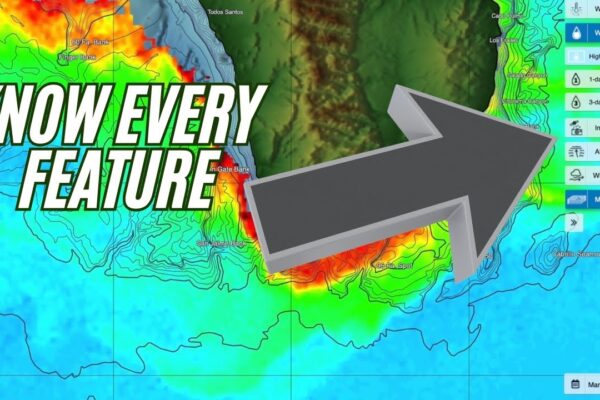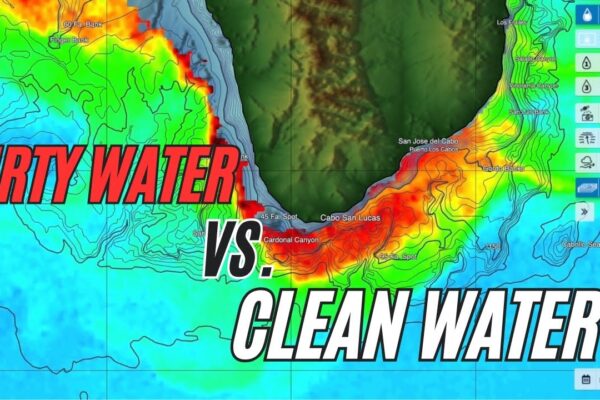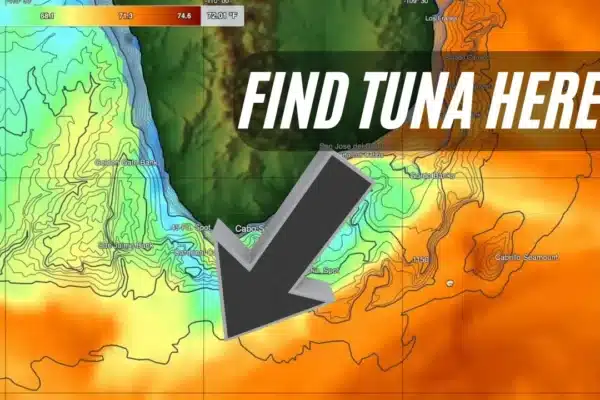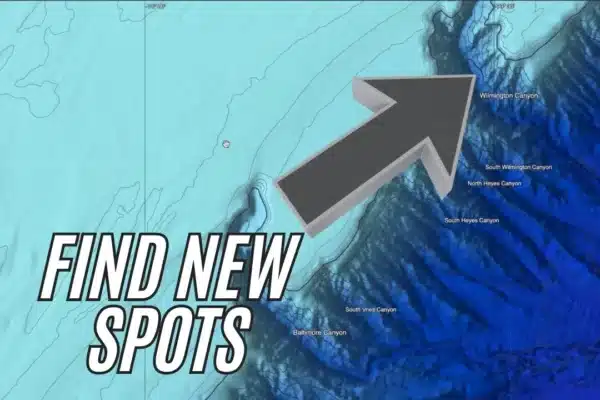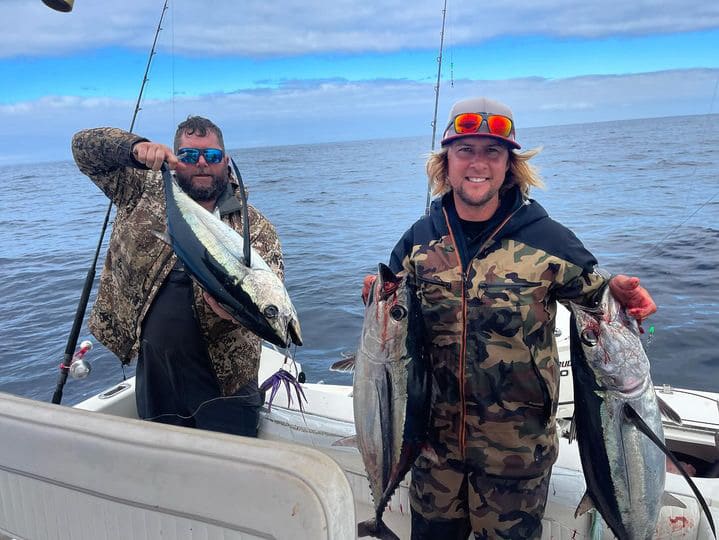
SatFish maps show you where to find ideal conditions for albacore:
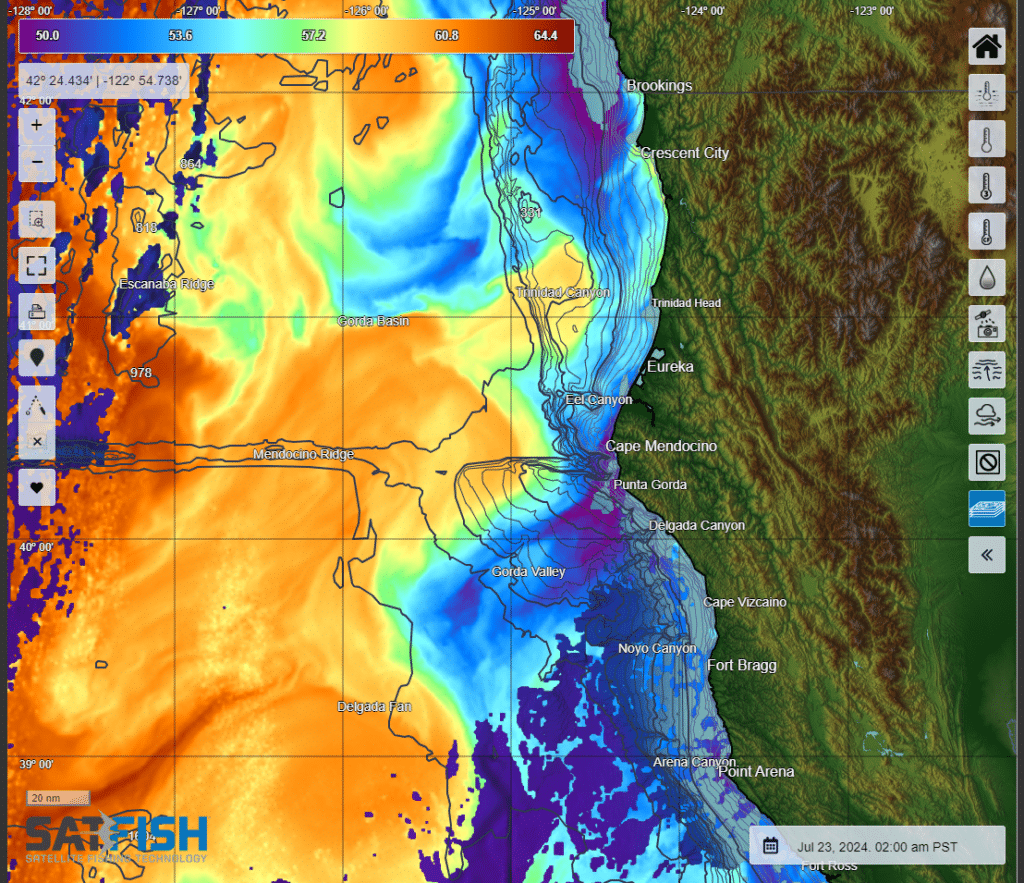
- Sea Surface Temperature:
58-68°F / 14-20°C
(60-66°F / 15-18°C is ideal) - Water Color / Chlorophyll:
Clean blue, 0.01-0.5 mg/m3 - Bathymetry:
Deep water, especially around canyons & seamounts
Look For:
- Clean purple-blue to off-blue water, especially near color breaks (you’ll occasionally find albacore on the greener side of the break, but they’re usually on the clean side)
- 60-66°F surface temps, especially over offshore canyons and seamounts
- Best Bet: Temperate and color breaks where 60-66°F water that connects to open ocean water farther offshore pushes up against greener inshore waters
Albacore Migration Patterns
Albacore (Thunnus alalunga) are found in temperate and tropical waters worldwide. In the North Pacific, adults spawn in the subtropical waters between Hawaii and the Philippines and are usually found in cooler subsurface waters in these lower latitudes. Juveniles then migrate to the rich, productive feeding grounds off the west coast of North America from Baja California, Mexico to Vancouver Island, Canada, arriving around July through September before returning to the central and western Pacific later in the Fall through early Spring. In some years the albacore arrive as early as mid-May, but an old saying among long-time captains is to “Shoot off your fireworks [on the 4th of July] first, then go look for albacore.”
The migration path in most years brings the bulk of the juvenile and subadult albacore to more northern parts of the West Coast, especially off the coast of Oregon and Washington. When oceanographic conditions are right, however, they also flood into Southern California and northern Baja. These latitudinal cycles tend to switch on and off roughly every 15-25 years, with the last southerly cycle occurring from the 1997-1998 El Niño until around 2010. The “off” periods leave SoCal anglers eagerly awaiting their return and asking themselves every Spring, “Is this the year albacore are coming back?”
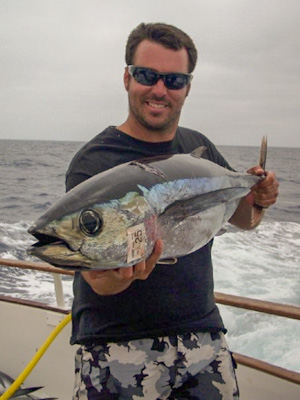
Along the West Coast, most albacore catches range from 10-25 lbs., with the smaller 1-2 year-old, 5-12 lb. “peanuts” often the first fish to show up in the summer. Later in the season you may also start to find bigger albacore into the 30-50 lb. range as older 3-5 year-old juveniles and 5+ year-old adults arrive to the grounds.
Where to Find Albacore Using SatFish Maps
Albacore prefer cool, clean offshore waters. You’ll usually find them where surface temperatures are 60-66 degrees Fahrenheit, sometimes down to 58° or as warm as 68°. Given their highly migratory nature across the expanses of the Pacific, they’re usually found where the clean 60-65° degree water “connects” to similar clean conditions farther offshore. It’s fairly rare to find them in isolated pockets where they would have to cross through dirty water, except rarely for short periods of time when a pocket of clean water pinches off from more offshore waters.
Use SatFish high-def SST and Chlorophyll maps to look for temperature and color breaks from deep purple-blue to off-blue. These breaks mark where productive, plankton-rich coastal waters have pushed out away from the coast and are mixing with the cleaner offshore water. They also show current breaks and slicks which gather up plankton, baitfish, and the gamefish that follow. Albacore will usually be found on the clean side of the color break, but they’ll occasionally stray into off-blue or blue-green water nearby if that’s where the bait is hiding.
Pro Tip: There’s often a lot of cloud cover in regions where albacore are found. The Cloud-Free SST layer can give you a “big picture” idea of where the right 60-66F offshore water is pushing in from offshore, even when clouds block the high-def satellites from showing sharp breaks.
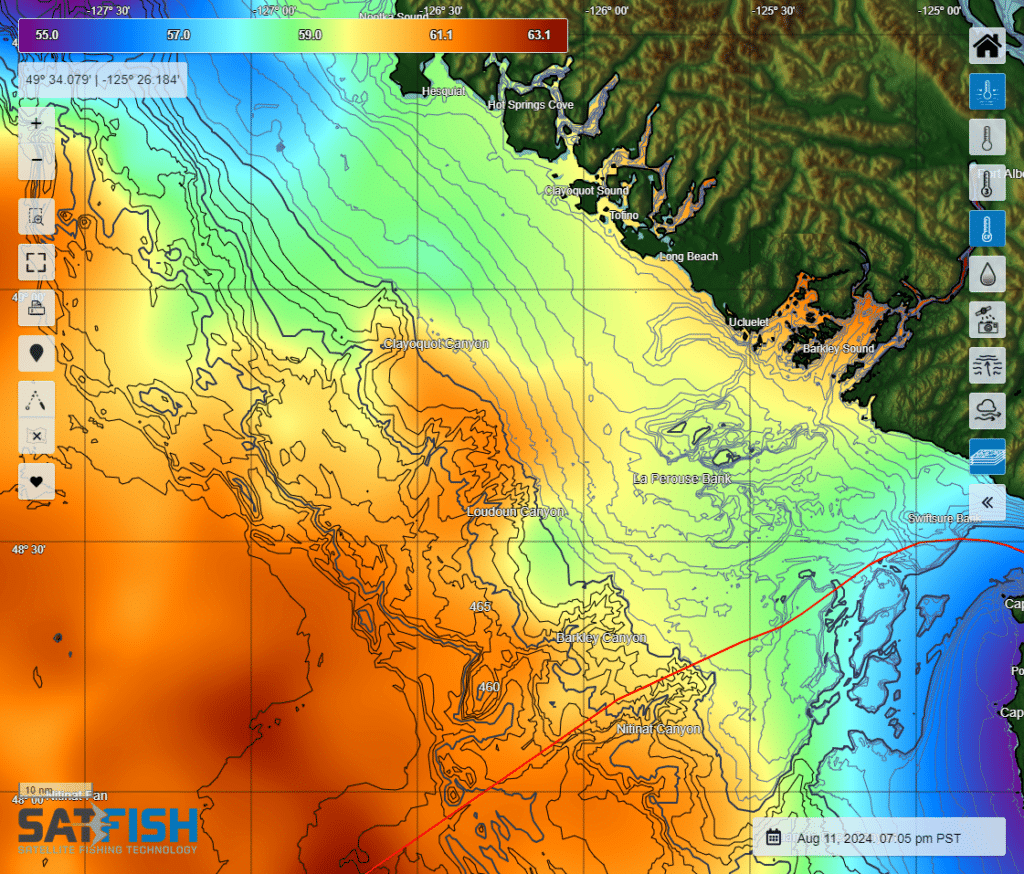
Albacore are typically found in deep offshore waters. They’ll gather up around seamounts and canyons that drop off from the continental shelf, as these areas tend to create good areas of upwelling which bring nutrient-rich waters to the surface. When albacore are feeding, you’ll find them chasing schools of baitfish from the surface down to 200 feet or deeper.
How to Catch Albacore
Above all, the most common way to catch albacore is by trolling to find a school, then “flylining” or “live lining” live finbait, especially anchovies, on light tackle. A spread of 4-6″ tuna feathers, cedar plugs, and diving plugs trolled at speeds from 5 to 8 knots will help you cover ground and locate these speedy tuna. Conventional wisdom is to use dark-colored feathers in low-light conditions at dawn, dusk, and overcast/cloudy weather, and switch to bright colors under bright sunny skies.
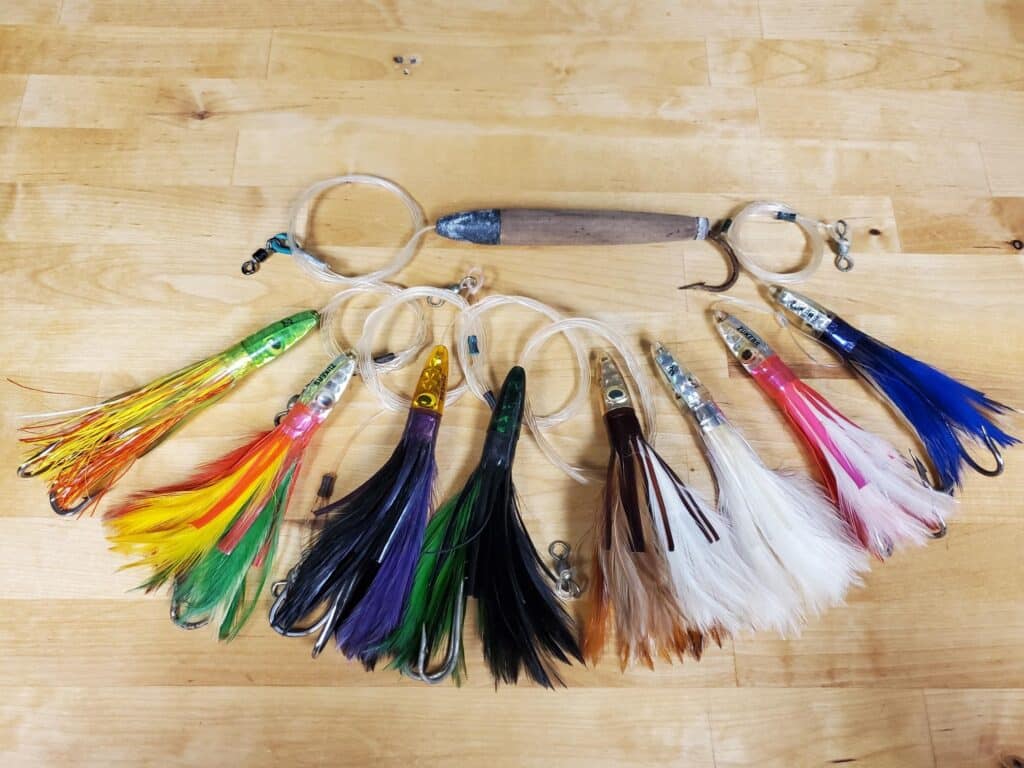
Once you get a jig strike, you can keep the boat in gear for another 5-10 seconds to try to turn a single into a double or triple. Then as you pull the boat out of gear and continue to slide forward, drop back a live anchovy, sardine, swimbait, or small metal jig to fish “the slide.” Chumming live anchovies can convince the rest of the school to come to the boat and whip them into a frenzy, making them an absolute blast to catch on light, 12-30 lb. tackle.
When the “longfins” are up near the surface, you’ll sometimes see signs of them such as breezers, jumping fish, and birds working over puddlers and boils to help you locate the main part of the school. Still, keep a close eye on your fishfinder as you troll through the grounds, as you’ll often be able to focus on areas with good bait marks and troll up steady single, double, and triple jig strikes even if you only mark an occasional tuna or two nearby. And when you do find a big “snowcone”-looking meter mark of a wad of bait balled up with tuna underneath, it’s game on!

